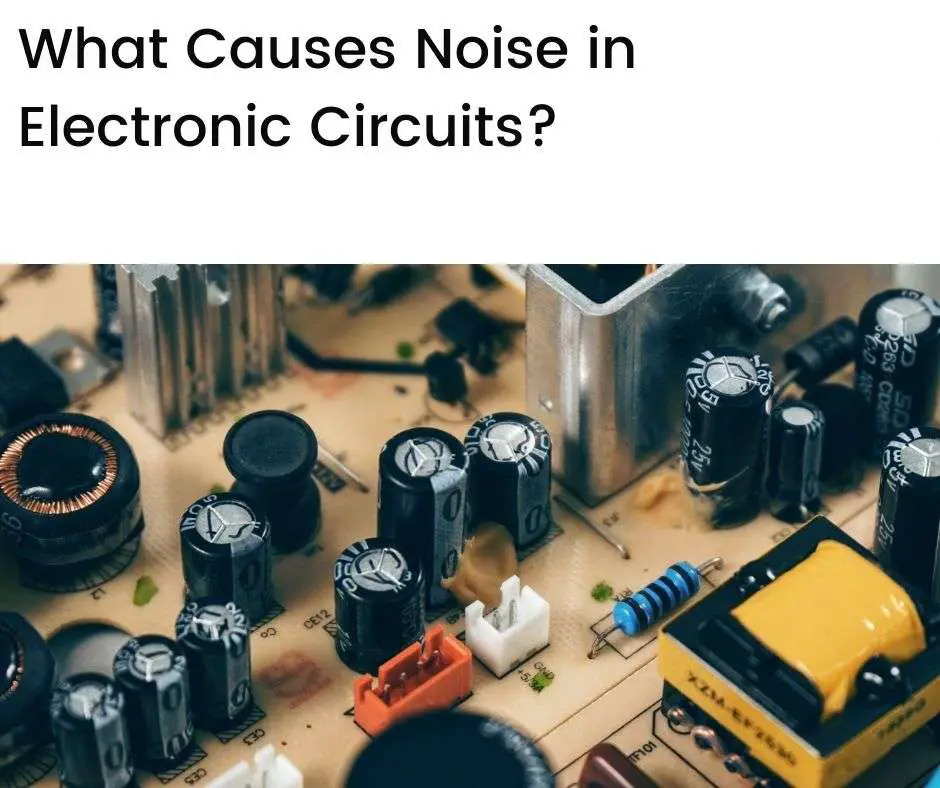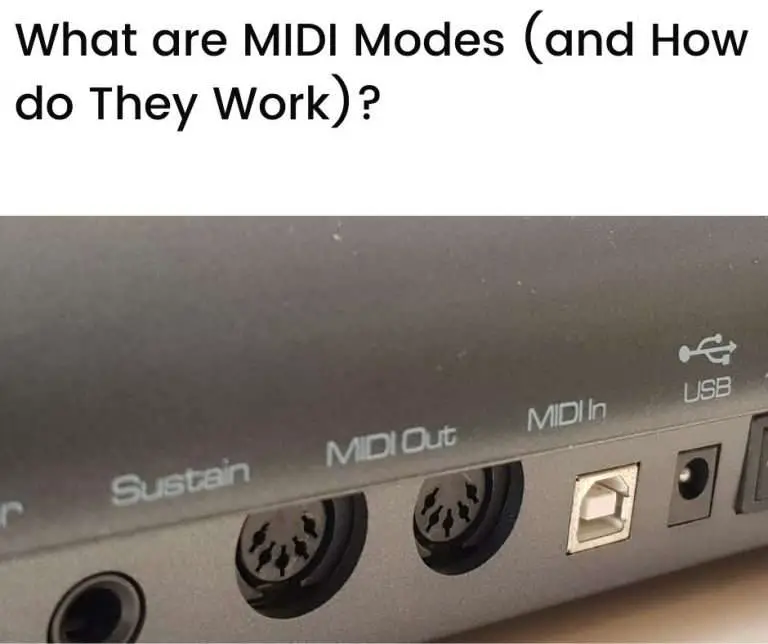Every electronic circuit generates noise due to its inherent physical properties and the nature of flowing electric charges. In audio applications, devices like audio interfaces produce noise from the electronic components they’re made from. Such noise is unavoidable, but keeping noise to a minimum is important in an audio workflow.
In this article we’ll look at:
- Sources of noise in electronic circuits
- Johnson noise
- Shot noise
- Flicker noise
- Burst noise
- Conclusion
- FAQs
Sources of noise in electronic circuits
In the audio production process, electronic noise can limit the quality and character of the sound produced.
Yet, modern audio workflows depend heavily on electronic devices—all of which generate noise—so identifying and managing noise in the production process is important.
Noise can be thought of as any unwanted signal that interferes with the desired signal in an audio workflow.
In this sense, there are many possible sources of noise—random signal fluctuations, wiring configurations, and the relative locations of different devices, for instance.
But there’s also noise arising naturally from the physical properties of electronic components and the nature of the electric charges flowing through them.
In this article, we focus on the noise arising naturally in electronic components.
This type of noise is a feature of the electronic devices used in modern audio workflows—it’s a key source of noise in audio interfaces, for instance.
The main types of noise generated by electronic components are:
- Johnson noise
- Shot noise
- Flicker noise
- Burst noise
Let’s look at each of these.
1. Johnson noise
Every resistor (a common component in electronic circuits) generates noise based on the thermal fluctuations it experiences.
This type of noise is known as Johnson noise (also called Nyquist noise).
Johnson noise is often referred to as white noise because it has a flat frequency spectrum, i.e., it has approximately the same power across a wide range of frequencies.
The amount of Johnson noise generated by an electronic resistor depends on the temperature it’s operating under and the range of frequencies (bandwidth) being applied to it.
The noise level can be calculated in voltage terms by using a constant known as Boltzmann’s constant, with the following equation:
v (noise) = 2(kTRB)1/2
Where:
- v (noise) is the open-circuit Johnson noise (as a voltage)
- k is Boltzmann’s constant
- T is the temperature (measured as degrees Kelvin = degrees Celsius + 273.16)
- R is the value of resistance provided by the resistor (measured in ohms, Ω)
- B is the range of frequencies being applied, or bandwidth (measured in Hz)
So, for a 10 kΩ resistor operating at room temperature applied across a 10 kHz bandwidth, the Johnson noise voltage is 1.3 micro-volts.
Johnson noise applies to any electronic component that has resistance (not only resistors), including signal sources and amplifiers, and is the minimum level of noise that these components will produce—other sources of noise will only add to it.
2. Shot noise
Electric currents flow as a series of discrete electric charges that have their own behavior and fluctuations—they’re not smooth or fluid-like.
If we assume that these fluctuations are independent of each other (i.e., that no particular electric charge influences another one in any discernible way), then the noise of the fluctuating current is given by:
i (noise) = (2qIB)1/2
In this equation:
- i (noise) is the noise of the fluctuating current (in amps)
- q is the standard electron charge (i.e., 1.6 x 10-19 coulomb)
- I is the current level that’s flowing (measured in amps)
- B is the range of frequencies being applied, or bandwidth (measured in Hz)
So, if a 1 amp (steady) current flows across a 10 kHz bandwidth, then the shot noise current is 57 n-amps (an n-amp is 1-billionth of an amp).
Although the above equation gives us a useful indication of shot noise, it assumes independent fluctuations of the electric charges in the current.
This assumption holds approximately true in some cases (when charges travel across a barrier, for instance, as in a junction diode) but not in other cases (e.g., when charges are traveling through metallic conductors).
Nevertheless, the above equation for shot noise provides a conservative estimate of the likely shot noise that may arise.
3. Flicker noise
The noise types discussed so far—Johnson noise and shot noise—are considered to be irreducible forms of noise because they’re based on the physical properties of electronic components.
What this means in relation to Johnson noise, for instance, is that whether you’re using an expensive or a cheap resistor, the (Johnson) noise will be exactly the same—it arises inherently due to the physical properties of the resistor regardless of its build quality.
Flicker noise is a type of noise that arises in addition to inherent physical noise, i.e., it adds noise beyond Johnson and shot noise in electronic components.
Flicker noise arises due to fluctuations in the level of actual resistance in a resistor.
The amount of flicker noise that’s generated depends on a number of factors, including the composition and design of a resistor.
Wire wound resistors, for instance, have a typical flicker noise in the range of 0.01-0.2 micro-volts, while carbon composite resistors are in the 0.1-3.0 micro-volts range—an order of magnitude higher.
Flicker noise is sometimes referred to as pink noise to differentiate it from white noise (i.e., Johnson and Shot noise).
The voltage density of pink noise decreases exponentially with frequency, whereas white noise is generally constant with frequency. Pink noise, therefore, tends to be more prominent at lower frequencies while white noise is more prominent at higher frequencies.
4. Burst noise
The noise types that we’ve been discussing so far have amplitudes that vary more or less smoothly with frequency. Other types of noise, such as those found in some semiconductors, show jumps in amplitude over time—this is referred to as burst noise.
Burst noise is sometimes called popcorn noise or bistable noise to describe its unstable characteristics—when heard on a loudspeaker, for instance, it often sounds like the cracking of popcorn.
Like flicker noise, the voltage density of burst noise decreases exponentially with frequency.
So, burst noise also tends to be more prominent at lower frequencies relative to white noise.
Burst noise was more common in the earlier days of semiconductor usage, due to inconsistencies in the manufacturing process. It’s less common these days as the standards of semiconductor manufacturing have improved significantly.
Conclusion
There are many possible causes of noise in an electronic system and the components that make up the system have an inherent tendency to produce noise. This is due to their physical properties and the nature of the electric charges that flow through them.
There are four main types of noise that arise naturally in electronic circuits:
- Johnson noise
- Shot noise
- Flicker noise
- Burst noise
Johnson and shot noise depend on the physical properties of electronic components and have a uniform density across a wide frequency spectrum. These are often referred to as white noise.
Flicker noise arises due to random variations in the resistance of electronic components as electric charges flow through them. It decreases exponentially with frequency, so it tends to dominate white noise at lower frequencies.
Burst noise occurs in random jumps and may sound like popcorn cracking if heard through a loudspeaker. It also decreases exponentially with frequency and so tends to dominate at lower frequencies. It’s less common nowadays as the manufacturing process of semiconductors—where burst noise usually arises—has improved significantly.
FAQs
What is electrical noise?
Electrical noise is an unwanted signal that interferes with the original electrical signal. It can be caused by various disturbances such as internal and external sources of noise, electromagnetic interference, power supply noise, and more.
What is thermal noise?
Thermal noise, also known as Johnson noise, is the random noise generated by the thermal agitation of electrons in a conductor. It is proportional to the temperature of the conductor and its bandwidth.
What are the different types of electronic noise?
There are various types of electronic noise, including Johnson noise, Shot noise, Flicker noise, Burst noise, and more.
What is voltage coupling?
Voltage coupling occurs which a noise signal is induced by a voltage on an adjacent conductor. It’s also referred to as capacitive coupling.
What are electrical signals?
Electrical signals are the fluctuation of voltage or current in a circuit. They can be affected by interference, noise, and coupling.
What is interference in electronics?
Interference in electronics refers to the distortion or interruption of an electrical signal caused by noise, unwanted signals, or external factors.







